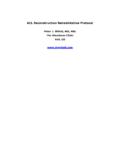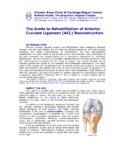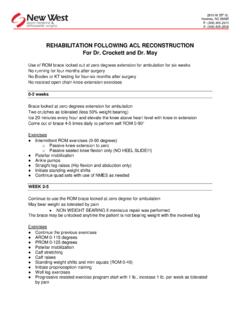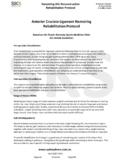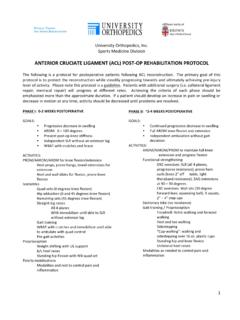Transcription of ACL Reconstruction Using Quadriceps Tendon Autograft
1 Daniel J. Prohaska, Advanced Orthopaedic Associates 2778 N. Webb Rd. / Wichita, KS 67226. Phone (316) 631-1600 ext 249, 239, or 270 / Fax (316) 631-1666. ACL Reconstruction Using Quadriceps Tendon Autograft Criterion Based Postoperative ACL Quadriceps Tendon Reconstruction Rehabilitation *Because this procedure only requires harvest of a portion of the Quadriceps Tendon rehabilitation can begin with minimal soft tissue limitations. Watch for excessive Quadriceps pain with exercises, however immediate weight bearing and flexion range of motion have no real restrictions. PHASE I (PREOPERATIVE) Goals Restoration of ROM both active and passive Reduced knee swelling Reduced knee pain Weight bearing status Weight bearing as tolerated, crutches as needed Exercises Extension stretching (heel props, towel stretch, prone hangs) Flexion exercises (heel slides, supine flexion hangs) Straight Leg Raise x 4 Quadriceps sets Hamstring sets Leg press Mini squats Step downs Criteria to Progress to Phase II Surgical Reconstruction Restoration of ROM Restoration of Quadriceps and hamstring strength Minimal pain and swelling PHASE II (DAYS 1 14)
2 Goals Restoration of ROM both active and passive Full extension and 110 flexion by end week 1 Full extension and 130 flexion by end week 2 Reduced knee swelling Reduced knee pain Weight bearing status Weight bearing as tolerated, crutches as needed Full weight bearing with no antalgic gait by 3 weeks Exercises Extension stretching (heel props, towel stretch, prone hangs) Flexion exercises (heel slides, supine flexion hangs) as tolerated Straight Leg Raise x 4 Quadriceps sets in full extension with or without electrical stimulation Hamstring sets Ankle pumps Weight shifting as tolerated Continuous Passive Motion Standing terminal knee extension (Knee lockouts) Cryotherapy for edema and effusion Criteria to Progress to Phase III Clean and dry wound/incisions Restoration of ROM (Full extension and 130 flexion) Straight leg raises with minimal extensor lag Improved Quadriceps and hamstring strength Minimal pain and swelling PHASE III (WEEKS 2 4)
3 Goals Restoration of ROM both active and passive Maintain full weight bearing Improve balance and proprioception Minimize knee swelling Minimize knee pain Weight bearing status Full weight bearing with no antalgic gait by 3 weeks Exercises Previous exercises Isometric Quadriceps sets against resistance at 0 , 90 and 60 Closed kinetic chain squats or leg press bilateral 0 60 Stationary bike with gradual increase in resistance Step downs Leg press Mini squats Calf raises bilateral Band exercises (lateral walking, monster walks) Single leg balance drills Bilateral single plane balance board Criteria to Progress to Phase IV Restoration of ROM (Full extension and 130 flexion) Equal motion bilaterally Normal gait without assistive device Single leg stance without assistance > 30 seconds Minimal pain and swelling PHASE IV (WEEKS 4 12) *PRECAUTION Graft at weakest point during this period.
4 No impact loading activities such as jumping, running, pivoting, or cutting. Goals Maintenance of ROM both active and passive Full bilateral equal flexion and extension No knee pain or swelling Preparation for activities Exercises Previous exercises Calf raises bilateral progressing to unilateral Squats and leg press 0 60 bilateral progressing to unilateral Lunges 0 60 Balance board multiple planes bilateral progressing to unilateral Single leg balance eyes open/eyes closed Ball toss while in single leg stance Sports cord resisted walking Single leg deadlift Core strengthening Criteria to Progress to Phase V Restoration of ROM (Full extension and 130 flexion) Equal motion bilaterally Normal gait without assistive device Single leg stance without assistance > 30 seconds Ability to bilaterally squat to 60 with equal weight bearing Minimal pain and swelling PHASE V (WEEKS 12+)
5 Goals Maintenance of ROM both active and passive Full bilateral equal flexion and extension No knee pain or swelling Preparation for activities Exercises Previous exercises Calf raises unilateral Progressive resistance for squats, leg press and lunge Continue core exercises Advance hamstring exercises Advanced balance exercises Start functional drills such as ladder drills, carioca at weeks 10 12 12 weeks + Mini jumping exercises progressing to hopping Perturbation exercises on balance board Increase speed of functional drills Functional activities such as jump shot, kicking soccer ball, ect. Begin progressive running program Criteria for Return to Activity Restoration of ROM (Full extension and 130 flexion) Equal motion bilaterally Normal gait Negative Lachman's test with excellent stability Single leg stance without assistance > 30 seconds Ability to bilaterally squat to 60 with equal weight bearing Minimal pain and swelling 80% bilateral symmetry and with reported norms on scores on functional tests
